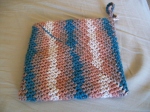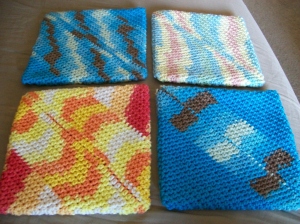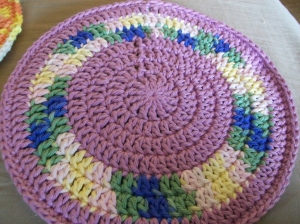Since my last post, I finished two sewing projects, made another potholder, and made a little bit of progress on my new knitting project. I also did a fair bit of tatting design/drafting, most of which has shown up as pattern posts here, and a bunch of fruitless drafting for another knitting project.
First, sewing: I finished the blue shirt I mentioned last time. I followed McCall’s M5929 with Mandarin collar and single ruffle options. I ended up having to modify the sleeves on the fly, changing from a banded sleeve to a hemmed sleeve with a pleat, because my arms have gotten a bit chubby in the last year and the bands wouldn’t fit. I was extremely short on fabric—I fit a 3 yard pattern into 2 yards, with the ruffle and plackets cut diagonally—and had thrown out the tiny scraps by the time I noticed this, so I couldn’t go back and extend or cut new bands. I’m reasonably pleased with what I ended up doing, which was to pleat the sleeves at the center of the hem and sew a button over the pleat. I was lucky with the buttons; they’re black with bits of blue in the middle, matching the shade of the fabric well, and I found 9 for a dollar, meaning I could space them closer together on the plackets and still have leftovers. More pictures (click for larger):


More sewing: This was a ludicrously quick project; I believe it took me only two days including a bit of pattern drafting/alteration, cutting, and seaming and hemming by hand. It also didn’t take much fabric—I had about a yard and a half of this gray flecked stuff hanging around, and it fit the pattern easily. The pattern started as New Look 6483, which is one of my old standbys, and I made considerable alterations. I’ve been thinking about making a knit, drape-neck shell out of my Harlequin colorway sock yarn (teal, green, purple and gold stripes), so I’d already traced the front and sleeve of the pattern onto newsprint, removed the seam allowances, and slashed and extended the neckband and  sleeves.
sleeves.  The pattern has no main darts, only a bust dart to the side seam, which I flipped into the neckline, and then I put two more slashes from the neckline to the armhole.
The pattern has no main darts, only a bust dart to the side seam, which I flipped into the neckline, and then I put two more slashes from the neckline to the armhole.  Anyway, when I decided to put the knitting on hold and do a sewing project instead, I taped these pieces to more newsprint, added the seam allowance back in, cut them out, and cut my fabric. Six seams and four hems later, it was done, and I’m pretty pleased—not my favorite shirt ever, and the fabric was not the best choice for drapeyness, but it’s certainly wearable and even a little dare-I-say glamorous.
Anyway, when I decided to put the knitting on hold and do a sewing project instead, I taped these pieces to more newsprint, added the seam allowance back in, cut them out, and cut my fabric. Six seams and four hems later, it was done, and I’m pretty pleased—not my favorite shirt ever, and the fabric was not the best choice for drapeyness, but it’s certainly wearable and even a little dare-I-say glamorous.
I’m glad I made this shirt primarily because I spent an entire day just drafting and doing arithmetic for a knit shirt, only to decide my first idea was impossible and my first fallback looked terrible. At least the manual part—tracing the pattern, rearranging the darts and slashing the sleeves—were good for something, as it wasn’t much work to add the seam allowances back on and turn it back into a sewing project. The idea, for the curious, was to attempt a fitted, drape-neck shell worked diagonally. I still think it should work, but I can’t keep everything in my head to work out the details. My first fallback was to switch from knit to crochet, which I’ve been doing longer and thus find easier, but it looked absolutely terrible so I just got disheartened. I think at some point soon I will pull out the drafting and work out a worked-horizontally version, which should be a lot easier, and leave the diagonals for when I am a much better drafter.
 Crochet: I made another square potholder; ’nuff said really, but I have a pretty picture. This one I put a hanging loop on, just because I had some extra yarn left. I enjoy the fact that the colorway lined up to make nearly vertical/horizontal stripes, in a diagonally-worked piece, without my having to put too much effort into making it happen.
Crochet: I made another square potholder; ’nuff said really, but I have a pretty picture. This one I put a hanging loop on, just because I had some extra yarn left. I enjoy the fact that the colorway lined up to make nearly vertical/horizontal stripes, in a diagonally-worked piece, without my having to put too much effort into making it happen.
Knit shawl: Again, not much to say, but I’ve added a few rows to my new knit shawl project. It’s now got a full repeat of the colorway, so here are some pictures:
I never thought I’d be a fan of pink mixed in with pale blues and greens, but I think it works quite well in this yarn. I also, while I was at the store for buttons for the blue blouse and some other odds and ends, picked up a skein of the “soft white” color of the same yarn, with which I plan to edge the shawl.









